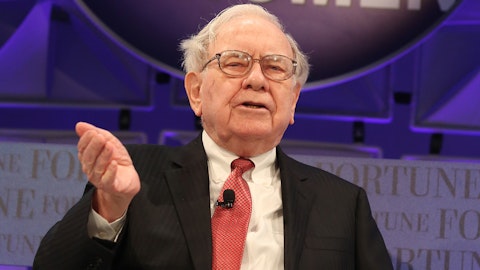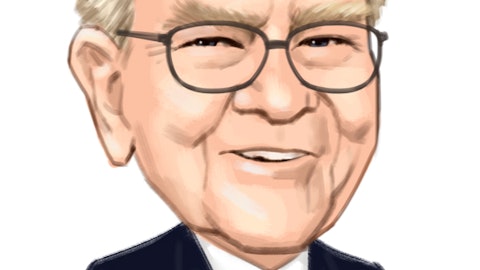Paramount Global (NASDAQ:PARA) Q3 2023 Earnings Call Transcript November 2, 2023
Paramount Global beats earnings expectations. Reported EPS is $0.3, expectations were $0.09.
Operator: Good afternoon. My name is Nadia, and I’ll be the conference operator today. At this time, I would like to welcome everyone to Paramount Global’s Q3 2023 Earnings Conference Call. [Operator Instructions] At this time, I would now like to turn the call over to Jaime Morris, Paramount Global, EVP, Investor Relations. You may now begin your conference call.
Jaime Morris: Good afternoon, everyone. Thank you for taking the time to join us for our third quarter 2023 earnings call. Joining me for today’s discussion are Bob Bakish, our President and CEO; and Naveen Chopra, our CFO. Please note that in addition to our earnings release, we have trending schedules containing supplemental information available on our website. Before we start this afternoon, I want to remind you that certain statements made on this call are forward-looking statements that involve risks and uncertainties. These risks and uncertainties are discussed in more detail in our filings with the SEC. Some of today’s financial remarks will focus on adjusted results. Reconciliations of these non-GAAP financial measures can be found in our earnings release or in our trending schedules, which contain supplemental information and in each case can be found in the Investor Relations section of our website. Now I will turn the call over to Bob.
Bob Bakish: Good afternoon, everyone, and thank you for joining us. There’s no question the media industry remains dynamic and in many ways, complex, but our performance this quarter demonstrates clear progress against strategic goals, as we set the company up to return to significant earnings growth in 2024. In the third quarter, we grew streaming revenue in Paramount Plus subscribers while narrowing D2C losses. Multiple lines of business benefited from a franchise strategy powered by Paramount Pictures, and our licensing business continued to be an important component of content monetization. At the same time, we remain disciplined in our approach to cost management, helping maximize earnings of our TV media business. Finally, as you can see, we delivered strong free cash flow in the quarter.
Beyond operations, our delevering plan continues to be a priority. And on Monday, we closed on the sale of Simon & Schuster for $1.62 billion. The net proceeds of which we will use to pay down debt. While we remain focused on executing our strategy to make world-class content with mass popular appeal, delivery across platforms and monetize it across multiple revenue streams, there’s never been a more important time for us to remain agile and adaptive as the industry continues to evolve. We are applying this thinking to every market we operate in, every line of business and every decision we make about the best use of our content. Today, I’ll provide more color on how we’re doing that with a focus on our D2C momentum. I’ll also share our perspective on the distribution and advertising landscape.
Two topics we know are top of mind with everyone on this call. With that, let’s dive in. Q3 was yet another significant step in our building of a scaled, profitable streaming business. Paramount Plus crossed 63 million subscribers, and we delivered 38% D2C revenue growth aided by a successful price increase. We also narrowed our D2C adjusted OIBDA losses by over 30%. In fact, we now believe 2022 was our year of peak streaming investment meaning D2C losses in 2023 will be lower than in 2022. We’re clearly advancing on the path to streaming profitability and this continued D2C improvement will be a key driver of the total company earnings growth we expect next year. Related to that, our integration of Paramount+ and Showtime continues to deliver as we expected.
Since it launched at the end of June, the combination has driven increases in acquisition and engagement, ARPU and operational efficiency. The power of partnerships is also a meaningful contributor to our momentum. The majority of Delta’s daily domestic customers now have in-flight access to Paramount+. Also, we recently completed the first year of our partnership with Walmart+ which continues to add to Paramount+ subscribers and grow viewer engagement. It’s also an incremental driver of consumer products franchises like Teenage Mutant Ninja Turtles, PAW Patrol and Yellowstone. And we continue to expand our participation in the global streaming market, leveraging a variety of different models tuned to market dynamics. In major territories like the U.K. and Australia, for example, we have an owned and operated streaming presence that benefits from cross promotion and programming with our local broadcast networks, much like we do in the U.S. with Paramount+ and CBS.
In certain smaller markets, we’re now prioritizing partner-centric distribution to further unlock the international streaming opportunity. Here, partners will ingest a subset of our content into a Paramount+ branded area on their platform. That way, we have a local partner fully engaged in driving the business forward and we can monetize our content and amplify the Paramount+ brand without the investment in local content, marketing or operating infrastructure. So the financial benefit is quite accretive. This new phase of expansion is just getting underway. In the past few weeks alone, we’ve locked deals in Belgium and in Greece with more on the way. And speaking of geographic reach Pluto TV continues to be in more countries today than any other fast service, and it had the highest total viewing hours ever in Q3, both domestically and globally.
And like our partner-centric Paramount+ strategy, Pluto allows us to tap into international streaming consumption in an economically efficient way. Moving on to distribution more broadly. Recent negotiations in the industry have raised questions about whether the hard bundling of streaming and pay TV will become the norm in the U.S. and what that could mean for companies like ours. The reality is, operators have different priorities, but we’ve shown that we can adapt our partnerships to accomplish common objectives. As we go forward, it is possible that some of our partners will embrace the strategy that more tightly integrates DTC into the Pay TV bundle. And we expect that if they do, the bundles would have many of the same advantages we’ve observed in the various hard bundles we’ve deployed internationally, namely a dramatically lower cost of acquisition and improvement in streaming churn, and it may improve TV ecosystem trends as well.
In addition, adding the scale of U.S. pay TV to Paramount+ ad supported tier would bring incremental benefit to our digital advertising offering as well as an additional marketing and promotional value and it would provide an opportunity to upsell to Paramount+ with Showtime. As a result, these deals, when structured with the right economic value have the potential to be additive to our model while improving simplicity and increasing value for the consumer. As a related point, it’s worth noting that we have already finalized agreements with multiple distributors to offer Paramount+ with Showtime to their customers as a true multi-platform product. Importantly, this includes linear subscribers getting app credentials. That’s where we are and where we’re headed on distribution.
Now let’s talk about advertising. There’s no question that the broader ad market continues to face challenges, impacted by inflation, economic uncertainty and weaker demand from some categories. And while the industry isn’t seeing the second half recovery we expected earlier in the year, there are a number of positive catalysts ahead that give us confidence as we continue to navigate the headwinds. As in distribution, we have prepared for the advertising transition from linear to digital, and we’ve built the asset base and the team to prosper in it. On the supply side, continued growth in our streaming users and engagement means we will extend our position as one of the market’s largest sources of high-quality digital video through IQ. In fact, we’re now reaching over 100 million full episode monthly unique viewers in the U.S. alone.
This audience will continue to grow as we launch Paramount+ Essential on Amazon channels in the U.S. in the coming months, and we’re about to launch IQ globally allowing marketers to operate multinational campaigns across Paramount’s domestic and international digital platforms, all with a user-friendly single point of entry. In 2024, we will create even more opportunities for global ad growth. For example, in the U.K., we’re launching a consolidated ad-supported offering that combines Channel 5’s broadcast video-on-demand platform, My5 with Pluto TV. We’re also rolling out a new ad-supported tier for Paramount+ in select other markets including Australia and Canada. Simultaneously, we’re strengthening our hand to better serve the demand side.
We’re enhancing and expanding the collection of first-party data across Paramount+ and Pluto TV. And we’re continuing to bring in new advertisers into our digital video ecosystem from the large and growing small and medium business market. There are currently tens of thousands of longer tail advertisers buying across IQ as part of a programmatic only cohort, a cohort that only continues to grow. The fact is, CTV can compete for media budgets previously earmarked for other formats like social. And while we expand our business with long-tail video advertisers, Paramount remains very well positioned to serve larger clients through our direct sales force. There are a number of other bright spots anticipated in 2024 and including the Super Bowl, where inventory is virtually sold out and it’s an election year, so we can expect to see the benefit of higher political spending.
Powering all of these opportunities is our world-class content both our scale collection of first run and library IP. It’s what draws viewers in and keeps them coming back. It’s what makes us a first choice partner and what drives the continued success of our strategy. It’s our greatest strength and remains our greatest focus. And as we’re talking about content, I’d note that we’re happy that WGA deal was reached and ratified. It’s a deal that’s good for our company and our industry. At the same time, you saw that we recently made some changes to our film slate, which has been impacted by the continued SAG-AFTA strike. And while late night is back up and running, the scripted side of TV is still strike impacted. Obviously, we all hope to be back at work soon.

Despite the dynamics we’re navigating, you saw the power of our content in the quarter, whether it shows on Paramount+ like Special Ops: Lioness and Shy both of which were significant sources of fibers and engagement or CBS shows like Survivor, Amazing Race and 60 minutes as well as sports like the NFL, all of which drove audiences on linear and streaming. In fact, I’m happy to say the NFL on CBS is delivering its best season in viewership in years and its most streamed season to date on Paramount+ which, among other things, illustrates the power of our platforms in terms of reach and consumer engagement. It’s also about our kids and family franchises like Turtles and PAW Patrol, both of which had successful feature films. Films, which also drove a broader ecosystem of consumption on linear, streaming and at retail.
And we look forward to future extensions, including the release of a new Teenage Mutant Ninja Turtle series next year and a third PAW Patrol movie in 2026. I also have to mention the Yellowstone universe. Over the last 5 years, over 100 million viewers globally have watched the Yellowstone franchise across platforms. Not only is Yellowstone a top franchise in the U.S., it’s a top show for Paramount Plus in markets, including the U.K., France, Canada and across Latin America. And it’s another perfect example of how we use the combined power of our platforms and partners to extend reach, revenue and relevance of our biggest hit. This first-run content, combined with our massive library of titles from Spongebob to NCIS drove momentum across our platforms, including Pluto TV as well as our third-party licensing business.
This unique collection of world-class content is driving consumers, platforms and commercial activity with partners broadly speaking, and it’s what makes Paramount one of the preeminent media companies in the world. Finally, I want to leave you with two points. First, with content at the core, Paramount’s combination of advertising, subscription and licensing revenue streams continues to provide attractive growth opportunities and diversification. This is particularly important during a period of rapid industry evolution. And second, now that we remain laser-focused on execution and our return to earnings growth in 2024. With that, I’ll hand it to Naveen to walk you through our numbers and provide additional commentary. Naveen?
Naveen Chopra: Thank you, Bob, and good afternoon, everyone. As Bob outlined, we’ve made substantial progress in improving DTC earnings year-to-date and now expect to deliver lower full year DTC losses in 2023 than in 2022. The with further improvement next year as we return to consolidated earnings growth. Broadly speaking, Paramount’s Q3 results reflect two important takeaways strong momentum in our D2C business, and our ability to navigate in a challenging environment by focusing on operational efficiencies across the company. In my comments today, I will provide additional insights on key elements of our Q3 results. I’ll also discuss our expectations for Q4 and outline our path ahead. Let’s begin with our Q3 results. We delivered total company revenue of $7.1 billion and adjusted OIBDA of $716 million.
You’ll find a comprehensive review of our key financial results in our press release. But let me walk you through a few important areas. First, affiliate and subscription revenue, which grew 14% in Q3. This demonstrates the power of our multi-platform strategy and affirms that the combination of traditional and streaming continues to yield growth for our business. In TV media, affiliate revenue reflects a continuation of the trends we saw in the first half of the year. This quarter, affiliate and subscription revenue included two pay-per-view events, which benefited both our TV media and D2C segments. D2C subscription revenue grew 46% in Q3, anchored by over 60% growth in Paramount+ subscription revenue. This growth was achieved through a combination of healthy subscriber additions and global ARPU expansion.
Paramount+ added 2.7 million subscribers this quarter, even as we lost 1.3 million Latin American subs due to the restructuring of a legacy hard bundle deal, which we previewed on our last earnings call. Q3 was also the first full quarter in which the new Paramount+ with Showtime service was operational. As expected, this offerings expanded content proposition led to increased engagement among premium tier subscribers. In fact, for premium subs, hours of engagement grew 17%. Simultaneous with the launch of Paramount+ with Showtime we increased monthly pricing, which helped Paramount+ ARPU grow 16%. I should note here that the price increases took effect at different times for different subscriber cohorts throughout the quarter. meaning we won’t see the full ARPU benefit of the price increase until Q4.
In addition, we were pleased that domestic monthly churn continued to improve year-over-year despite the price increase demonstrating the popularity and stickiness of our content. From a bottom line perspective, strong revenue trends, together with significant improvements in our D2C operating leverage contributed to a 31% year-over-year improvement in D2C OIBDA in the quarter. Looking ahead, we expect strong D2C revenue growth with another quarter of healthy sub growth. That said, Q4 D2C losses will be similar to the year ago period. This reflects higher sports costs as well as higher marketing costs to support our broader geographic footprint as most of our Western European launches occurred late in the fourth quarter of 2022. Nonetheless, as I noted earlier, we now expect full year D2C losses in 2023 to be lower than 2022.
Meaning we are ahead of plan in moving the D2C business toward profitability. The ongoing execution of our streaming strategy will yield further improvement in 2024 as we continue to drive subscriber growth user engagement and Paramount+ global ARPU growth in excess of 20%. In addition, we remain focused on building operating leverage by capturing the benefits of integrating Paramount+ and Showtime, optimizing our programming strategy to efficiently target key audience segments and further expanding our international footprint in a financially efficient way. Now let’s discuss advertising. Direct-to-consumer advertising growth remained strong at 18%, benefiting from 46% growth in total viewing hours across Paramount+ and Pluto TV. This quarter’s growth continues to position Paramount as one of the largest digital video advertising platforms with a unique direct programmatic business that leverages deep relationships with advertisers and agencies.
TV media advertising revenue declined 14%. We did see strong sports demand and healthy year-over-year growth in key categories like automotive, CPG and alcohol. But significant categories like tech and pharma were weaker than we would like. Additionally, reduced political spend, strike-related impacts and international headwinds, including from FX negatively impacted the year-over-year performance. Looking ahead to Q4, advertising growth will continue to be impacted by a sizable decline in political advertising. We’re seeing modest improvement in domestic linear advertising, but we continue to deal with strike impact and international weakness, which will limit improvement in the year-over-year trend. Shifting gears a bit, I’d like to provide additional detail regarding the financial impact of the strikes.
In Q3, total company OIBDA included nearly $60 million of strike-related idle costs. These are incremental expenses incurred to retain production capabilities while the strike is ongoing. These costs impacted both our TV media and filmed entertainment segments. We expect to incur additional strike-related idle costs in Q4. However, the magnitude of these incremental expenses will depend on when the active strike is resolved, which, of course, we hope happens soon. Now I’ll turn to Filmed Entertainment. Revenue was up 14%, benefiting from the theatrical performance of Mission Impossible-Dead Reckoning and Teenage Mutant Ninja Turtles: Mutant Mayhem. OIBDA was a loss of $49 million, which reflects release timing and film performance but also includes the impact of the strikes.
In addition to the idle costs I described above, the strike also negatively affected revenue from third-party studio rental and production services. This had a roughly $20 million impact on Filmed Entertainment OIBDA in the quarter. Bob has spoken about how we’re remaining adaptable and strategic in the face of industry-wide change. That includes proactively managing our cost base as we transform our business for the future. Earlier, I mentioned some of the initiatives we’re prioritizing to improve D2C operating leverage. We also continue to identify new efficiency opportunities through disciplined expense management across segments, in content, in marketing and overhead. Our decisions to reduce real estate footprint, prioritize content investments with global appeal, combined international broadcast video-on-demand platforms with Pluto TV and centralized more marketing activity are just a few examples of our ongoing and relentless focus on expense management and will all contribute to earnings growth next year.
Moving on to free cash flow. Free cash flow in Q3 was $377 million, and we expect strong free cash flow in Q4 as the strike continues to limit the production of content. Some of the programming changes we’ve made in response to the strike will be sustained, resulting in lower steady-state production spend and improved cash flow across the two year period of 2023 and 2024, which will also benefit leverage. We also closed on the sale of Simon & Schuster earlier this week, which generated approximately $1.3 billion in after-tax proceeds. These proceeds will improve year end net leverage by approximately one-half turn. Today, we announced a $1 billion tender offer for some of our upcoming debt maturities. Not only will this reduce gross debt, but it will extend our maturity profile thereby enhancing financial flexibility.
Additionally, next year, the full year benefit of the dividend reduction, together with our expectation for growth in total company earnings will improve leverage even further. In closing, I want to reiterate that despite a changing environment, our commitment to investors remains the same. We are well-positioned to deliver significant consolidated earnings growth in 2024. We’ll continue to improve D2C earnings through a combination of subscriber growth, healthy global ARPU expansion and operational efficiency. And we remain highly focused on maximizing earnings from our traditional networks by proactively managing expenses in these areas. We continue to believe that successfully transitioning Paramount’s business will yield significant long-term value creation for our shareholders.
And with that, operator, can you please open the line for questions.
See also 12 Stocks that Could Skyrocket According to Investment Newsletters and 10 Best Social Media Platforms For eCommerce.
Q&A Session
Follow Paramount Global (NASDAQ:PARAA,PARA)
Follow Paramount Global (NASDAQ:PARAA,PARA)
Operator: [Operator Instructions] Our first question today go to Michael Morris of Guggenheim. Michael, please go ahead. Your line is open.
Michael Morris: Thank you. Good afternoon, guys. Thank you for all the details. Bob, you talked about the carriage agreement. The new agreement between Disney and Charter and the streaming app side of the business. But can you share thoughts about the elimination of carriage of some channels that came in with that agreement and whether that’s something that you expect to work through as you do renewals in the future and how that might impact the business? And sorry, if I could just add one other. If we look at the 2024 outlook for returning to earnings growth, Naveen, could you maybe talk a little bit about what that assumes for the advertising environment and cost growth at direct-to-consumer? Thank you.
Bob Bakish: Yes. Sure, Mike, happy to. Look, there’s been a lot of conversation about this topic, Disney Charter, if you will. And if we end up going in this direction with some partners — and by the way, it’s not clear that all partners want to go this direction. But if we go this direction, we think it could be an accretive development. And I’ll talk about the DTC side and the channel side. So first, in many respects, this is a domestic hard bundle idea. And we’ve seen clear benefits with international hard bundles, namely increased subs, no acquisition cost and lower churn. That is offset by a lower potential D2C unit revenue, given that in some shape or form, you’ll be dealing with a wholesale structure. But still, when you net it all, we see the LTV as compelling.
Also, I would point out importantly that we’ve seen these hard bundles actually catalyze DTC growth through channel stores and O&O, et cetera, which is obviously a positive. So there are puts and takes to this piece, but the aggregate value that we’ve seen is clearly positive. When you extend the question to the broader distributor economic relationship, obviously, that includes linear channels, if you will. Remember, all major deals include premium networks, advanced ad sales and data relationships, as well as marketing partnerships, plus in some cases, there are film and other types of content output deals. So there are a lot of levers here to pull as you get to what ends up being a bespoke solution. And again, I’d look to international. We’ve done this internationally, as discussed on prior earnings calls, the result was D2C was launched, revenue was remixed a bit, total revenue increased.
And importantly, to your question, no linear channels were dropped. So in aggregate, that’s clearly a positive outcome. And lastly, on a related point, I’d note that we’ve already done a number of P+ with Showtime deals with major operators in the U.S. where they get credentials for the Showtime linear subs, as an example. And we like those very much. So again, we think this is an interesting accretive — potentially accretive development. We don’t know if it applies broadly, but we’re excited by it. And to you, Naveen.
Naveen Chopra: Yes. Mike, with respect to earnings in 2024, I’d note a few things. I mean, first, we remain very focused on delivering consolidated earnings growth next year. In terms of the composition of that, the TV media side of the business, we assume we’ll continue to benefit from cost reductions. Obviously, get some tailwind on the advertising side from the Super Bowl and political, all of which help offset continued evolution in the linear ecosystem. I would say that we — with respect to the advertising market specifically, we do expect it to improve in 2024. Obviously, the exact magnitude of that would be a little too early to call but we have a number of levers that we can pull to adjust our plan depending on what we see in the advertising market to ensure that we’re achieving our desired level of earnings.
On the B2C side of the business, we continue to expect significant improvement in the D2C P&L. That is a combination of both top-line growth and improved operating leverage. I’ve talked about some of the drivers there in the past, includes things like growth in subs, continued improvement in engagement and ARPU both on the subscription and advertising side. It improves — it involves continued improvement in churn as well as lower growth in content, marketing and operational expenses. So those are the drivers. It’s, I think, too early to put specific numbers around that, given some of the uncertainty, both in the advertising marketplace as well as timing of content availability, but doesn’t change the fact that there are a number of levers that contribute to year-over-year earnings growth.
Jaime Morris: Thanks, Mike. Operator, next question, please.
Operator: Our next question goes to you, Ben Swinburne of Morgan Stanley. Ben, please go ahead. Your line is open.
Ben Swinburne: Good afternoon. I guess two questions. Bob, could you talk a little bit about your kind of longer-term ambitions for Paramount on the film slide? I know the slate has been impacted — excuse me, by the strike, but there’s a lot of momentum in the IP there. I’m just wondering if you could talk about maybe over the next couple of years, what you think the studio should be doing in terms of number of wide releases and what your strategy is to maximize value for the studio. And then Naveen, since you’re being very helpful with 2024, I thought I would push a little further just to take a swing. Is there a way you could help us think about like total cash content spending year-on-year 2024 versus 2023 or even total OpEx for the company growth? Because the allocation between segments gets pretty tricky for us externally. So, just kind of think maybe more bigger picture on cost in 2024 would be helpful. Thank you guys.
Bob Bakish: Yes. Sure, Ben. Obviously, let me start there. When you look at Paramount and you look at the slate, the word that comes to my mind is balance. And what I mean by that is a mix of titles for target market and a genre perspective — by the way, they saw five titles opened at number one in this year. We’ve obviously got a range of budget levels in there from modest to larger and a mix of franchises and new ideas. And so let’s talk a little about franchises since I think that’s part of your question. Look, we continue to believe in them. We have seen our franchises contribute significant value really across the business because, again, we use Paramount Pictures as part of an integrated strategy. Theatrical window is very much a launch pad, but it yields other benefits beyond theatrical.
Look at the kids and family genre, clearly, a strong point in the quarter. You had Turtles and PAW Patrol. Those are both successful feature films, but they really drove a broader ecosystem of consumption on our platforms and at retail. In terms of consumption, it’s worth noting that, but again, both in linear and streaming, we saw a significant library benefit as well as traction from the new releases. And the retail value creation has been significant. On the Turtle side, it’s actually the fastest-growing action figure brand in the U.S., and it was number one in August. And on the PAW side, we’ve got the biggest pre — brand in merchandise. So that’s clearly additive, it’s part of the reason we feel great about our franchise strategy. In terms of where we go over the next couple of years, we like the slate.
It continues to be balanced. It continues to have range from genre and target market perspective, it continues to have range from — on budget. And again, it’s a mix of franchises and new ideas. If you look in the near term, we have Bob, the Bob Marley picture, One Love. That looks like a good sort of original idea, but clearly, a topic that people know. We got another Gladiator movie that we’re very excited about and then more franchises, A Quiet Place, Mean Girls, Smile, Transformers, Sonic. So there’s a lot going on there in the near term. But again, you can assume the slate continues in that vein, but scales a bit. We’re probably in the 8-ish release volume in the last year or two, that number probably ticks up marginally over time. Maybe we get up to a dozen in a couple of years.
But again, I think we’re going to — I know we’re going to feel a very balanced slate. We’re going to continue to drive franchises. We’re going to get value across the business. And we’re going to demonstrate what an incredible asset Paramount Pictures continues to be. Naveen?





